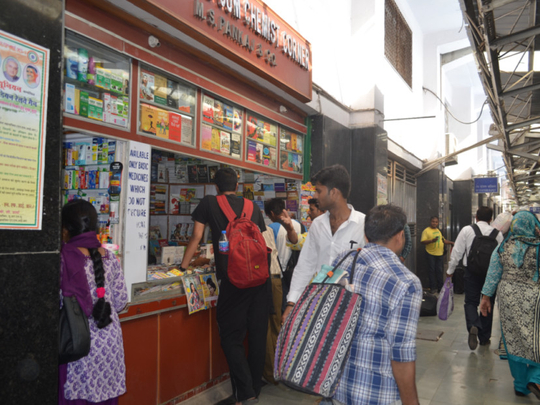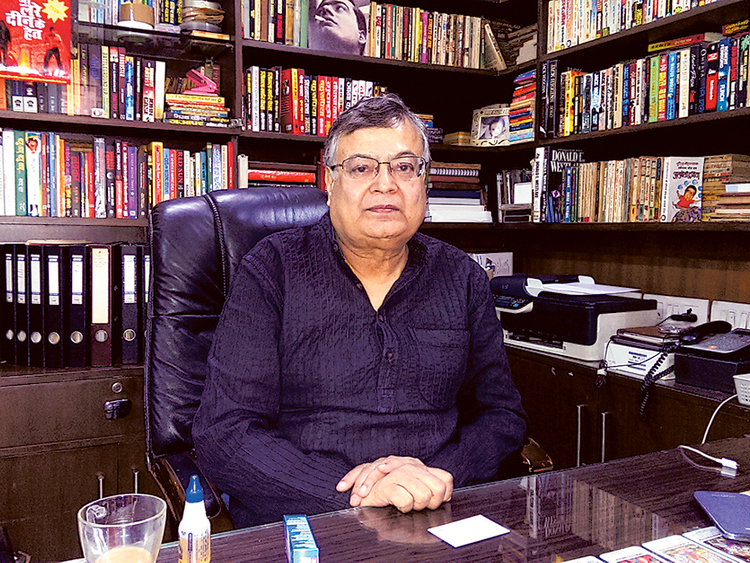
Visit any railway station bookshop in North India and it is hard to miss books with skimpily clad, voluptuous women and macho men on the covers, reminiscent of mainstream Hindi movie posters of yore. Called pocket books, these are sold for less than Rs100 (Dh5.75) each and have entertained generations in small towns and cities in the country.
However, these books and their authors were never considered mainstream. You would not find most of these books in traditional bookshops. Neither would you ever read a review of these works in national publications. Despite this, the books managed to create a huge fan base for themselves.
Though the neo-rich middle class and young generation would not be seen dead reading Hindi crime fiction, these books are the best bet if one is looking for some spicy, violent and racy content.
In their heyday, pocket books were often the only form of entertainment in small towns and cities. This nearly spawned an industry with close to 80 publishers. “A typical book would be 100-125 pages, with each page just having 20-22 lines. You could finish the book in a little more than half an hour. There was no differentiation between the writers ... the language, plot and characterisation was mostly standard. When I started writing there was no other media, such as the internet, TV ... Even radio was owned by few families. Everybody turned to the novel for entertainment, especially while travelling,” says Surender Mohan Pathak, or SMP as he is popularly known.
Pathak, one of the most prolific and recognised author of Hindi pulp fiction, has been writing for almost five decades. Even today, at the age of 75, he continues to write for up to nine hours every day.
The fact that the books were reasonably priced added to their allure. “When I started reading, they were available for 8 annas [50 paise] for a book, which most people could afford. In the 1960s the price increased to 12 anna [75 paise],” says Pathak.
In spite of their popularity, they continued to get stepmotherly treatment from mainstream publishers, media and literary houses. Even the publishers of Hindi literature treated these books with disdain. No surprise then that the writers of these books were hardly ever recognised and they continued to live in obscurity.
Things took a turn for the worse once mobile phones became popular. The masses no longer needed books to entertain themselves. Entertainment was now available at the press of a button. The advent of smartphones made the going tougher for writers and publishers of Hindi pulp fiction.
“The books market as a whole has suffered under the onslaught of new modes of mobile access to audio-visual entertainment, which inevitably impinges on the proportion of ‘timepass’ traditionally dedicated to crime novels,” says Dr Laura R. Brubeck, professor of Hindi literature at Northwestern University, who has been working on her research titled “Jasoosi Upanyas: The Hindi Detective Novel in Late 20th Century India”.
The online shopping boom ensured that a large number of bookstores closed down. This posed a challenge of distribution. “There were a number of distribution problems, which led to the closure of a significant number of book shops in small towns and cities. Because of this, the books were unable to reach the readers,” says Manish Gupta, chief executive officer, Raj Comics, which still publishes about four pocket books per author every year. He concedes that this category contributes just 5 to 10 per cent of their total revenue.
The tide has now turned again. The same technology is now helping in the revival of these books. Online e-commerce platforms, such as Flipkart and Amazon, proved to be blessings in disguise as they started selling them and these books are now accessible to a wider audience.
“Major sale of our books still happens at railway stations but online sales are definitely picking up. Nearly 10 per cent of our present sale happens online now,” says Gupta.
A survey by Amazon claimed that Pathak’s “Colaba Conspiracy” was the most popular book of 2014. It was closely followed by Chetan Bhagat’s much hyped “Half Girlfriend” and Sudeep Nagarkar’s “Sorry, You’re Not My Type”. It clearly underlines that Hindi writers are not lacking in popularity.
Pathak is easily one of the most influential writers of this genre. So much so that some crimes committed in the country were inspired by his books.
“The digital and mobile eras also open up new modes of access to crime novels, as e-books, audio books and as inspiration for television and cinematic adaptations that inspire new audiences — just look at the new life recently breathed into ‘Byomkesh Bakshi’,” says Dr Brueck.
Nevertheless, there is no denying that this genre is struggling for survival and the increase in online sales is only a tiny ray of hope, which might or might not change the fortunes of the writers.
Influx of new writers is essential for the growth of any genre. Unfortunately, that is yet to happen to Hindi pulp fiction.
“There are no more than four publishers today who publish Hindi crime fiction. There has been no new writer in this trade in the last 15 to 20 years. One reason is that publishers don’t encourage them ... they want to bank on established names. When the supply line is closed, the business will also close. I believe this business will close in the next eight or 10 years. It is a doomed trade ... it doesn’t have a future,” says Pathak.
But Pathak has managed to buck the downward trend in Hindi pulp fiction. He is the only author from this genre to be signed by the global publication house HarperCollins. Under the contract, two of Pathak’s novels will be published every year. “Colaba Conspiracy”, the first novel under this contract, was a runaway hit last year and was published thrice in the last year and a half. HarperCollins is planning to come out with its English translation soon.
“We would be publishing Pathak’s second book, “Crystal Lodge” in August this year. We will also bring out a box set of SMP favourites [five of his books] early next year. Pathak is a phenomenon and we are happy to be associated with him,” says Minakshi Thakur, senior commissioning editor at HarperCollins India.
However, Pathak is an exception and not the rule. Thakur is unequivocal about her disappointment with th equality of other books in this genre.
“We keep exploring other writers but haven’t come across many we would like to sign up. The reason is that they just don’t write well. I keep buying books from railway stations and most of the time, they don’t have any sense of plot, no characters and are in general very loosely tied,” says Thakur. She, however, acknowledges that they are exploring Ved Prakash Sharma, another iconic Hindi crime fiction writer.
Pathak, however, is sure in his pessimism. “It is extremely difficult for books in Hindi to survive. There are many publishers for books in English. A Hindi writer suffers on many counts — no identity, no money and waste of hard work,” says Pathak.
One way to overcome this language barrier is translation of these works, which then opens up a wider audience for them. However, few pocket books have been translated so far. Blaft Publishers, which has translated four novels, has witnessed a positive response. Pathak pointed out that in spite of writing for more than 40 years, he started getting some recognition when a few of his books were translated a decade ago.
“Translation in English offers Hindi crime fiction a brand new audience and injects a new creative energy in Hindi literature. Translation has been central to the development of the genre from the very beginning. I am very excited to see translations working the other way so that an English-reading audience has access to the vibrant world of vernacular crime novels. The more readers — in any language — the better,” says Dr Brueck.
Translations and online sales are indeed steps in the right direction. The fact that some of the writers have a huge base of admirers illustrates the demand for this kind of fiction.
Dr Brueck recalls the Crime Writer’s Festival held in Delhi earlier this year. “The majority of writers who engaged in discussion or made presentations write in English, but the festival’s first day was headlined by Hindi crime king SMP alongside throngs of fans in matching SMP T-shirts.”
Perhaps all is not lost. Perhaps there is hope for Hindi crime fiction, much like many a hero therein who, in a thrilling climax, resurrects himself — much to the delight of the reader who keeps coming back for more.
Gagandeep Kaur is an independent journalist based in New Delhi. You can follow her on Twitter @Gagandeepjourno










